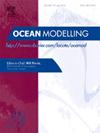Simulating ice–wave interactions in the Laurentian Great Lakes using a fully coupled hydrodynamic–ice–wave model
IF 2.9
3区 地球科学
Q2 METEOROLOGY & ATMOSPHERIC SCIENCES
引用次数: 0
Abstract
Hydrodynamic modeling in cold climate regions necessitates more sophisticated approaches that accurately simulate ice–wave interactions. Traditional models often overlook the complex coupling mechanisms between ice and ocean waves, especially the two-way processes where ice attenuates wave energy and waves break ice floes. This oversight can also intensify modeling challenges in coastal areas, including large lakes, where ice–wave interactions influence storm surges, high waves, and coastal erosion. To address this gap, this paper introduces an enhanced modeling approach that integrates both ice-induced wave attenuation and wave-induced ice breakage. To implement these processes, the Finite-Volume Community Ocean Model (FVCOM) is coupled with an unstructured-grid wave model (SWAN) and the unstructured-grid version of the Los Alamos Sea Ice Model (UG-CICE) to form the FVCOM–SWAVE–UG-CICE framework. Using this fully coupled model, simulations were conducted for the Great Lakes. Results of the modeled ice concentration, ice thickness, and significant wave heights were reported and validated against observational data from the U.S. National Ice Center (NIC) and in-situ under-ice measurements. To further study the coupling effects, results of the proposed model were also compared with those from no coupling and one-way coupling (focusing only on ice-induced wave attenuation) models. Comparative analyses demonstrated significant improvements in the predicted ice concentration with the proposed fully coupled model. These findings reveal the importance of incorporating ice–wave interactions in accurately predicting ice cover dynamics in freshwater systems.
利用完全耦合的水动力-冰波模型模拟劳伦森五大湖的冰波相互作用
寒冷气候地区的水动力模拟需要更复杂的方法来精确模拟冰波相互作用。传统的模型往往忽略了冰与海浪之间复杂的耦合机制,特别是冰衰减波能和海浪破坏浮冰的双向过程。这种疏忽也会加剧沿海地区(包括大型湖泊)的建模挑战,在这些地区,冰波相互作用会影响风暴潮、大浪和海岸侵蚀。为了解决这一差距,本文介绍了一种增强的建模方法,该方法集成了冰致波衰减和波致冰破。为了实现这些过程,将有限体积群落海洋模型(FVCOM)与非结构网格波浪模型(SWAN)和洛斯阿拉莫斯海冰模型(UG-CICE)的非结构网格版本耦合在一起,形成FVCOM - wave - UG-CICE框架。利用这一完全耦合模式,对五大湖进行了模拟。报告了模拟冰浓度、冰厚和显著波高的结果,并根据美国国家冰中心(NIC)的观测数据和冰下实测数据进行了验证。为了进一步研究耦合效应,将该模型的结果与无耦合和单向耦合(仅关注冰致波衰减)模型的结果进行了比较。对比分析表明,采用完全耦合模型预测冰浓度有显著提高。这些发现揭示了将冰波相互作用纳入准确预测淡水系统冰盖动态的重要性。
本文章由计算机程序翻译,如有差异,请以英文原文为准。
求助全文
约1分钟内获得全文
求助全文
来源期刊

Ocean Modelling
地学-海洋学
CiteScore
5.50
自引率
9.40%
发文量
86
审稿时长
19.6 weeks
期刊介绍:
The main objective of Ocean Modelling is to provide rapid communication between those interested in ocean modelling, whether through direct observation, or through analytical, numerical or laboratory models, and including interactions between physical and biogeochemical or biological phenomena. Because of the intimate links between ocean and atmosphere, involvement of scientists interested in influences of either medium on the other is welcome. The journal has a wide scope and includes ocean-atmosphere interaction in various forms as well as pure ocean results. In addition to primary peer-reviewed papers, the journal provides review papers, preliminary communications, and discussions.
 求助内容:
求助内容: 应助结果提醒方式:
应助结果提醒方式:


